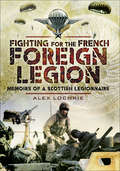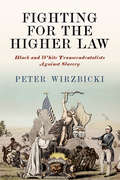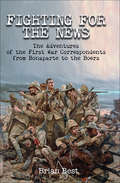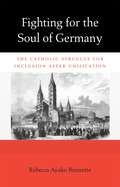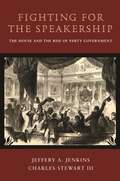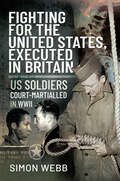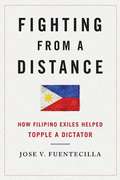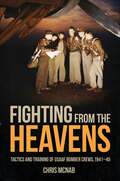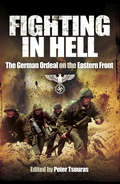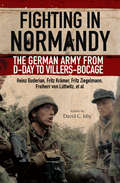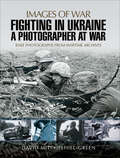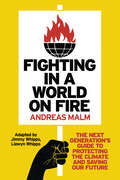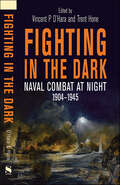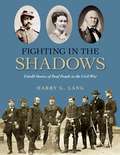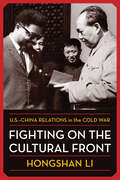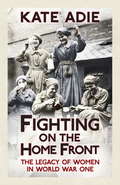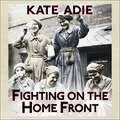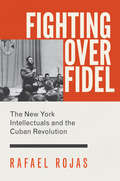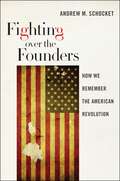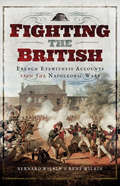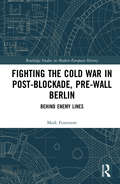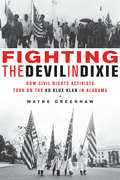- Table View
- List View
Fighting for the French Foreign Legion: Memoirs of a Scottish Legionnaire
by Alex LochrieA soldier’s true story of danger and adventure as a modern-day legionnaire in Kuwait, Bosnia, and beyond. With no French language ability, Alex Lochrie approached recruiters for the French Foreign Legion in Paris and embarked on the demanding selection process that followed. When he was accepted, he and other prospective legionnaires were sent to Southern France to begin the harsh recruit training course. The mix of nationalities and backgrounds among his fellows was enormous. New members are traditionally allowed to change their identities—and Lochrie chose to alter his age, becoming twenty-eight instead of thirty-eight. Elite paratrooper training followed in Corsica before Lochrie earned his wings. The FFL is never far from the front line, and in this book he tells of challenging active service in former French colonies in Africa as well as during the first Gulf War, evicting Saddam Hussein from Kuwait, and operations in Bosnia and Sarajevo. This gripping account lifts the veil of mystery and myth, pulling you into the action—and revealing much about the realities of service in the Foreign Legion.
Fighting for the Higher Law: Black and White Transcendentalists Against Slavery (America in the Nineteenth Century)
by Peter WirzbickiIn Fighting for the Higher Law, Peter Wirzbicki explores how important black abolitionists joined famous Transcendentalists to create a political philosophy that fired the radical struggle against American slavery.In the cauldron of the antislavery movement, antislavery activists, such as William C. Nell, Thomas Sidney, and Charlotte Forten, and Transcendentalist intellectuals, including Ralph Waldo Emerson and Henry David Thoreau, developed a "Higher Law" ethos, a unique set of romantic political sensibilities—marked by moral enthusiasms, democratic idealism, and a vision of the self that could judge political questions from "higher" standards of morality and reason. The Transcendentalism that emerges here is not simply the dreamy philosophy of privileged white New Englanders, but a more populist movement, one that encouraged an uncompromising form of politics among a wide range of Northerners, black as well as white, working-class as well as wealthy. Invented to fight slavery, it would influence later labor, feminist, civil rights, and environmentalist activism.African American thinkers and activists have long engaged with American Transcendentalist ideas about "double consciousness," nonconformity, and civil disobedience. When thinkers like Martin Luther King, Jr., or W. E. B. Du Bois invoked Transcendentalist ideas, they were putting to use an intellectual movement that black radicals had participated in since the 1830s.
Fighting for the News: The Adventures of the First War Correspondents from Bonaparte to the Boers
by Brian BestThe incredible true stories of the first reporters from the battlefield—from Europe&’s Napoleonic era to the Boer Wars of South Africa. Over two centuries ago, newspapers first considered sending a reporter overseas to observe, gather information, and write about war. With no experience to draw upon, both newspapers and correspondents gradually worked out a procedure that has evolved into today&’s incredibly sophisticated systems of reportage. Here are the gripping accounts of those groundbreaking adventurers who sought out the danger of battle in pursuit of a story. Included within are the exploits of such journalistic luminaries as the first real war correspondent, Henry Crabb Robinson, who was sent by The Times of London to act as their &‘man in Germany&’, ostensibly to follow and report the movements of Napoleon&’s Grande Armée; William Howard Russell in the Crimean War, whose reports helped change the British government&’s treatment of their soldiers; and perhaps the most famous correspondent of all, a young Winston Churchill who reported on conflicts in Cuba, the Indian frontier, Sudan, and the Boer War. For any fan of history, journalism, or true-life adventures, Fighting for the News is all you need to get the full story.
Fighting for the Soul of Germany: The Catholic Struggle for Inclusion after Unification
by Rebecca Ayako BennetteHistorians have long believed that Catholics were late and ambivalent supporters of the German nation. Rebecca Ayako Bennette’s bold new interpretation demonstrates definitively that from the beginning in 1871, when Wilhelm I was proclaimed Kaiser of a unified Germany, Catholics were actively promoting a German national identity for the new Reich. In the years following unification, Germany was embroiled in a struggle to define the new nation. Otto von Bismarck and his allies looked to establish Germany as a modern nation through emphasis on Protestantism and military prowess. Many Catholics feared for their future when he launched the Kulturkampf, a program to break the political and social power of German Catholicism. But these anti-Catholic policies did not destroy Catholic hopes for the new Germany. Rather, they encouraged Catholics to develop an alternative to the Protestant and liberal visions that dominated the political culture. Bennette’s reconstruction of Catholic thought and politics sheds light on several aspects of German life. From her discovery of Catholics who favored a more “feminine” alternative to Bismarckian militarism to her claim that anti-socialism, not anti-Semitism, energized Catholic politics, Bennette’s work forces us to rethink much of what we know about religion and national identity in late nineteenth-century Germany.
Fighting for the Speakership: The House and the Rise of Party Government (Princeton Studies in American Politics: Historical, International, and Comparative Perspectives #131)
by Jeffery A. Jenkins Charles StewartThe Speaker of the House of Representatives is the most powerful partisan figure in the contemporary U.S. Congress. How this came to be, and how the majority party in the House has made control of the speakership a routine matter, is far from straightforward. Fighting for the Speakership provides a comprehensive history of how Speakers have been elected in the U.S. House since 1789, arguing that the organizational politics of these elections were critical to the construction of mass political parties in America and laid the groundwork for the role they play in setting the agenda of Congress today. Jeffery Jenkins and Charles Stewart show how the speakership began as a relatively weak office, and how votes for Speaker prior to the Civil War often favored regional interests over party loyalty. While struggle, contention, and deadlock over House organization were common in the antebellum era, such instability vanished with the outbreak of war, as the majority party became an "organizational cartel" capable of controlling with certainty the selection of the Speaker and other key House officers. This organizational cartel has survived Gilded Age partisan strife, Progressive Era challenge, and conservative coalition politics to guide speakership elections through the present day. Fighting for the Speakership reveals how struggles over House organization prior to the Civil War were among the most consequential turning points in American political history.
Fighting for the United States, Executed in Britain: US Soldiers Court-Martialled in WWII
by Simon WebbThis book relates a chapter of American military history which many people would rather forget. When the United States came to the aid of Britain in 1942, the arrival of American troops was greeted with unreserved enthusiasm, but unfortunately, wartime sometimes brings out the worst, as well as the best, in people. A small number of the soldiers abused the hospitality they received by committing murders and rapes against British civilians. Some of these men were hanged or shot at Shepton Mallet Prison in Somerset, which had been handed over for the use of the American armed forces. Due to a treaty between Britain and America, those accused of such offences faced an American court martial, rather than a British civilian court, which gave rise to some curious anomalies. Although rape had not been a capital crime in Britain for over a century, it still carried the death penalty under American military law and so the last executions for rape in Britain were carried out at this time in Shepton Mallet. Fighting For the United States, Executed in Britain tells the story of every American soldier executed in Britain during the Second World War. The majority of the executed soldiers were either black or Hispanic, reflecting the situation in the United States itself, where the ethnicity of the accused person often played a key role in both convictions and the chances of subsequently being executed.
Fighting from a Distance: How Filipino Exiles Helped Topple a Dictator
by Jose V. FuentecillaDuring February 1986, a grassroots revolution overthrew the fourteen-year dictatorship of former president Ferdinand Marcos in the Philippines. In this book, Jose V. Fuentecilla describes how Filipino exiles and immigrants in the United States played a crucial role in this victory, acting as the overseas arm of the opposition to help return their country to democracy. A member of one of the major U.S.-based anti-Marcos movements, Fuentecilla tells the story of how small groups of Filipino exiles--short on resources and shunned by some of their compatriots--arrived and survived in the United States during the 1970s, overcame fear, apathy, and personal differences to form opposition organizations after Marcos's imposition of martial law, and learned to lobby the U.S. government during the Cold War. In the process, he draws from multiple hours of interviews with the principal activists, personal files of resistance leaders, and U.S. government records revealing the surveillance of the resistance by pro-Marcos White House administrations. The first full-length book to detail the history of U.S.-based opposition to the Marcos regime, Fighting from a Distance provides valuable lessons on how to persevere against a well-entrenched opponent.
Fighting from the Heavens: Tactics and Training of USAAF Bomber Crews, 1941–45
by Chris McNab"...expands our knowledge of bomber operations, making it a most welcome addition to the aerial combat literature." — The Journal of America's Military Past During World War II, the US Army Air Forces (USAAF) projected American military might across distances and with destructive force unimaginable just a decade previously. The B-17s and B-24s of the US Eighth Air Force, for example, turned much of Germany’s infrastructure to twisted steel and burnt rubble between 1943 and 1945. B-29 Superfortresses unleashed conventional raids on Japan of even greater area destruction than that created by the atomic bomb attacks (also delivered by USAAF crews). Beyond heavy strategic bombing, US bombers performed a multitude of other tactical roles, including hunting Axis submarines, bombing enemy shipping, low-level runs against precision targets, and providing heavy air support to advancing infantry and armor. While the US bombers dealt out violence, however, they were also prey to a terrifying spectrum of antiaircraft threats, and by the end of the war 88,119 US airmen had died in service. Bomber crews were a world unto themselves, composed of pilots, co-pilots, engineers, navigators, wireless operators, gunners, and bombardiers. And each aircraft type had its own unique characteristics and capabilities, from twin-engine B-25 Mitchells designed for strafing and skip-bombing to the four-engine workhorses of the strategic bombing campaign: the B-17 Flying Fortress, B-24 Liberator, and B-29 Superfortress. Fighting from the Heavens: Tactics and Training of USAAF Bomber Crews, 1941–45 presents an invaluable collection of material from US wartime manuals, including doctrinal, training, technical, aircraft-specific, and position-specific publications. Through these manuals, the reader gains an insider’s insight into the demands of US bomber warfare, including long-distance navigation, gun-turret operation, formation flying, bomber start-up procedures, and bomb aiming.
Fighting in Hell: The German Ordeal on the Eastern Front
by Peter TsourasDetailed reports by German commanders: &“Powerful testimony to the Germans&’ lack of preparation for the harsh climatic conditions of the Russian winter.&” —Military Machines International When their troops invaded the Soviet Union in 1941, the initial success convinced the German high command that the Red Army could be destroyed west of the Dnepr River and that there would be no need for conducting operations in cold, snow, and mud. They were wrong. In fact, the German war in Russia was so brutal in its extremes that all past experience paled beside it. Everything in Russia—the land, the climate, the distances, and above all the people—were harder, harsher, more unforgiving, and deadlier than anything the German soldier had ever faced before. One panzer-grenadier who fought in the West and in Russia summed it up: In the West war was the same honorable old game; nobody went out of his way to be vicious, and fighting stopped often by five in the afternoon. But in the East, the Russians were trying to kill you—all the time. The four detailed reports of campaigning in Russia included in this invaluable book (Russian Combat Methods in WWII, Effects of Climate on Combat in European Russia, Combat in Russian Forests and Swamps and Warfare in the Far North) were written in the late 1940s and early 1950s as part of the US Army program to record the German strategies and tactics of World War II directly from the commanders. The authors were all veterans of the fighting they described, and frankly admitted that the soldiers sent to Russia were neither trained nor equipped to withstand the full fury of the elements. Fighting in Hell shows what happened on the ground, through firsthand accounts of the commanders who were there.
Fighting in Normandy: The German Army from D-Day to Villers-Bocage
by David C. IsbyCollected in-depth accounts from Nazi commanders chronicling their efforts to fight back against the Allied invasion at Normandy during World War II. The Allied landings on the Normandy beaches in June 1944 were brilliantly executed but proved to be just the opening phase of a desperately fought battle. The German Army responded to the invasion with as much ferocity and force as it could muster, and turned the struggle into a brutal and prolonged campaign. These in-depth reports by German commanders given the task of turning the tables on the invaders is crucial to a full understanding of the battle for Normandy. The accounts David Isby has selected, all written soon after the war&’s close for American military intelligence, cover German attempts to stem the invasion, dramatic defensive battles in the Norman countryside and attempts to implement a series of counterattacks. This vital source material presents the German perspective on the fighting, from regimental to corps level, and graphically illustrates the wealth of problems faced by an army on the very brink of destruction.
Fighting in Ukraine: A Photographer at War (Images of War)
by David Mitchelhill-GreenThis WWII pictorial history shares the personal images captured by a German photographer and soldier who fought on the Eastern Front. The outcome of the Second World War was decided on the Eastern Front. Denied a swift victory over Stalin&’s Red Army, Hitler&’s Wehrmacht found itself in a bloody, protracted struggle that it was ill-prepared to fight. Fighting in the Ukraine captures the drama and struggle of the Eastern Front through the extraordinary personal record of a professional photographer, Walter Grimm, who served in the German Army in a communications unit. David Mitchelhill-Green brings Grimm&’s previously unpublished photographs together with a highly informative introduction. The 300 evocative black and white images provide an absorbing insight into the daily life and privations of the ordinary German soldier amid the maelstrom of history&’s largest conflict. The Ukrainian people, many of whom initially welcomed the Germans as liberators, freeing them from Bolshevik oppression, are also chronicled in this fascinating photographic study.
Fighting in a World on Fire: The Next Generation's Guide to Protecting the Climate and Saving Our Future
by Andreas MalmAn argument for bold action to halt climate destruction, adapted for young people from Andreas Malm&’s best-selling bookYoung people are inheriting a world of climate catastrophe. Young people are also one of the strongest forces leading movements for climate justice, and to halt the fossil fuel emissions that are making our Earth unlivable. As Greta Thunberg and the Fridays for the Future movement have made clear, solutions offered by adults are far too little, far too late: the measures in unenforceable international agreements won&’t halt our reliance on fossil fuels, or take the drastic steps humans need to take in order to keep our planet livable.What kinds of drastic steps are needed? What kind of bold actions can the climate justice movement begin using to bring a stop to climate destruction, and that can be employed alongside existing strategies of mass protest, awareness, and legal appeals? Why does our society consider profit for oil companies more important than the future of young people and the health of our shared environment?In this adaptation of Andreas Malm&’s best-selling book on the need for a bolder, more confrontational climate justice movement, these urgent questions are brought to the most important audience of all: those who are growing up in a world on fire.
Fighting in the Dark: Naval Combat at Night, 1904–1945
by Vincent O’Hara and Trent HoneFighting in the Dark is a new book about naval combat at night; the title also, however, signifies the overarching theme of the book, of moving from dark to light: in short, the process of mastering technological change during war. The authors start with the proposition that it is hard to hit an invisible target, particularly one in motion. In the nineteenth century, when ships relied upon visual signaling and vessels beyond hailing range were deaf and mute in the dark, night battles at sea were rare and largely accidental. Three inventions changed this: the torpedo, the searchlight, and the radio. These inventions at the end of the nineteenth and start of the twentieth centuries transformed naval warfare by making combat in the dark feasible and in some cases, desirable. The process by which navies used the dark and adapted it into a medium for effective combat was long and difficult, more so for some than others. This book is about that process and about how Russian, British, German, Italian, Japanese and US navies confronted the specific new challenges and adapted to unfamiliar situations and emerging technologies. Fighting in the Dark consists of chapters written by a group of highly respected naval historians, and the book’s approach illuminates how different navies and cultures approached common problems. The fierce night-time battles that are described serve as a metaphor for the larger issues and the reader is led along a fascinating journey of naval warfare from the Russo-Japanese War, through WWI, to the Second World War, and from the Pacific to the English Channel.
Fighting in the Shadows: Untold Stories of Deaf People in the Civil War
by Harry G. LangThis visually rich volume presents Harry G. Lang’s groundbreaking study of deaf people’s experiences in the Civil War. Based on meticulous archival research, Fighting in the Shadows reveals the stories of both ordinary and extraordinary deaf soldiers and civilians who lived through this transformative period in American history. Lang documents the participation of deaf soldiers in the war, whose personal tests of fortitude and perseverance have not been previously explored. There were also many deaf people in noncombat roles whose stories have not yet been told—clerks and cooks, nurses and spies, tradespeople supporting the armies, farmers supplying food to soldiers, and landowners who assisted (or resisted) troops during battles. Deaf writers, diarists, and artists documented the war. Even deaf children contributed actively to the war efforts. Lang pieces together hundreds of stories, accompanied by numerous historical images, to reveal a powerful new perspective on the Civil War. These soldiers and civilians were not “disabled” by their deafness. On the contrary, despite the marginalization and paternalism they experienced in society, they were able to apply their skills and knowledge to support the causes in which they ardently believed. Fighting in the Shadows is a story of how deaf civilians and soldiers put aside personal concerns about deafness, in spite of the discrimination they faced daily, in order to pursue a cause larger than themselves. Yet their stories have remained in the shadows, leaving most Americans, hearing and deaf, largely unaware of the deaf people who made significant contributions to the events that changed the course of our nation’s history. This book provides new insights into Deaf history as well as into mainstream interpretations of the Civil War.
Fighting in the Sky: The Story in Art
by John Fairley&“The thoughtful text and assortment of paintings illustrate just over a century of military aviation, from those early biplanes . . . to modern drones.&” —Military Model Scene Barely a decade passed from the Wright Brothers&’ first powered flight to aircraft becoming lethal instruments of war. The Royal Flying Corps and Royal Naval Air Service took off in the very early days of The Great War and captured the public&’s imagination and admiration. Sydney and Richard Carline happened to be both pilots and artists as was Frenchman Henri Farre. Their works inspired celebrated painters like Sir John Lavery who took to the skies in an airship in the First World War. Feeding on the demand for works depicting this new dimension of warfighting, a new genre of art was born which has remained popular ever since. During the Second World War, the paintings of Paul Nash stood out as did Eric Ravilious who, ironically, died in an air crash. War artist Albert Richards dropped with British paratroopers on D-Day. Post-war, paintings by leading British and international artists graphically illustrate conflicts such as the Falklands, Bosnia and the Gulf War. John Fairley has brought together a dazzling collection of art works covering over 100 years of air warfare, enhanced by lively and informative text. The result is a book that is visually and historically satisfying.&“This book is highly recommended based upon the outstanding prose, spectacular artwork, and coverage of the histories of the conflicts covered.&” —IPMS/USA&“Taken together, the paintings and descriptions present a compelling tableau of the first century of military operations in the third dimension.&” —Aviation History Magazine
Fighting on Two Fronts
by James E. WestheiderThe racial tensions that have long plagued American society exist to a much lesser extent in the military where the bond of common pursuit and shared experience renders race less relevant. Or so conventional wisdom has long held. In this dramatic history of race relations during the Vietnam war, James E. Westheider illustrates how American soldiers in Vietnam grappled with many of the same racial conflicts that were tearing apart their homeland thousands of miles away. Over seven years in the making, Fighting on Two Fronts draws on interviews with dozens of Vietnam veterans--black and white--and official Pentagon documents to paint the first complete picture of the African American experience in Vietnam. Westheider reveals how preconceptions and petty misunderstandings often exacerbated racial anxieties during the conflict. Military barbers, for instance, were often inexperienced with black hair, leading black soldiers to cut each other's hair, an act perceived as separatist by their white counterparts. Similarly, black soldiers often greeted one another with a ritualized handshake, or dap, as a sign of solidarity, the unfamiliarity of which threatened many white soldiers and was a source of resentment until it was banned in 1973. Despite ample evidence of institutional racism in the armed forces, the military elite responded only when outbreaks of racial violence became disruptive enough to threaten military discipline and attract negative attention from the civilian world. A crucial addition to our understanding of Vietnam, Fighting on Two Fronts is a compelling example of the new military history at its finest.
Fighting on the Cultural Front: U.S.-China Relations in the Cold War (A Nancy Bernkopf Tucker and Warren I. Cohen Book on American–East Asian Relations)
by Hongshan LiThe Cold War conflict between the United States and the People’s Republic of China did not only encompass political, military, diplomatic, and economic clashes. The two powers also confronted each other on the cultural front. Despite a long history of extensive and mostly constructive cultural interactions, the two nations cut off existing ties in the late 1940s and early 1950s, and established new relationships aimed at attacking and isolating each other. Even after Beijing and Washington permitted cultural exchange as part of their effort to normalize diplomatic relations in the 1970s, the weaponization of cultural interactions continued.Hongshan Li provides a groundbreaking account of the confrontation between the United States and the People’s Republic of China on the Cold War’s cultural front. He investigates the origins, evolution, and significance of the role of cultural interactions in the shifting relations between the United States and the PRC from the late 1940s through the late 1970s. Li demonstrates that the drastic transformation of U.S.-China cultural interactions not only altered the course of Sino-American cultural relations but also shaped the Cold War experience of the two peoples. Fighting on the Cultural Front examines topics such as competition and conflicts over Chinese students and scholars stranded in the United States, maneuvers on the authorization of journalistic exchanges, the establishment of Taiwan as a cultural bastion, and Beijing’s promotion of its revolutionary ideology through individual U.S. citizens, particularly African Americans. This important book offers a new lens on the history of U.S.-China relations and the cultural side of the global Cold War.
Fighting on the Home Front: The Legacy of Women in World War One
by Kate Adie'History at its most celebratory' Daily Telegraph'Adie uses her journalistic eye for personal stories and natural compassion to create a book definitely worthy of her heroines' Big Issue'Fascinating, very readable . . . provides a complete wartime women's history' Discover Your History* * * * * *Bestselling author and award-winning former BBC Chief News Correspondent Kate Adie reveals the ways in which women's lives changed during World War One and what the impact has been for women in its centenary year.IN 1914 THE WORLD CHANGED forever. When World War One broke out and a generation of men went off to fight, bestselling author and From Our Own Correspondent presenter Kate Adie shows how women emerged from the shadows of their domestic lives.Now a visible force in public life, they began to take up essential roles - from transport to policing, munitions to sport, entertainment, even politics. They had finally become citizens, a recognised part of the war machine, acquiring their own rights and often an independent income.The former BBC Chief News Correspondent charts the seismic move towards equal rights with men that began a century ago and through unique first-hand research shows just how momentous the achievements of those pioneering women were.This is history at its best - a vivid, compelling account of the women who helped win the war as well as a revealing assessment of their legacy for women's lives today.
Fighting on the Home Front: The Legacy of Women in World War One
by Kate Adie'History at its most celebratory' Daily Telegraph'Adie uses her journalistic eye for personal stories and natural compassion to create a book definitely worthy of her heroines' Big Issue'Fascinating, very readable . . . provides a complete wartime women's history' Discover Your History* * * * * *Bestselling author and award-winning former BBC Chief News Correspondent Kate Adie reveals the ways in which women's lives changed during World War One and what the impact has been for women in its centenary year.IN 1914 THE WORLD CHANGED forever. When World War One broke out and a generation of men went off to fight, bestselling author and From Our Own Correspondent presenter Kate Adie shows how women emerged from the shadows of their domestic lives.Now a visible force in public life, they began to take up essential roles - from transport to policing, munitions to sport, entertainment, even politics. They had finally become citizens, a recognised part of the war machine, acquiring their own rights and often an independent income.The former BBC Chief News Correspondent charts the seismic move towards equal rights with men that began a century ago and through unique first-hand research shows just how momentous the achievements of those pioneering women were.This is history at its best - a vivid, compelling account of the women who helped win the war as well as a revealing assessment of their legacy for women's lives today.
Fighting on the Home Front: The Legacy of Women in World War One
by Kate Adie'History at its most celebratory' Daily Telegraph'Adie uses her journalistic eye for personal stories and natural compassion to create a book definitely worthy of her heroines' Big Issue'Fascinating, very readable . . . provides a complete wartime women's history' Discover Your History* * * * * *Bestselling author and award-winning former BBC Chief News Correspondent Kate Adie reveals the ways in which women's lives changed during World War One and what the impact has been for women in its centenary year.IN 1914 THE WORLD CHANGED forever. When World War One broke out and a generation of men went off to fight, bestselling author and From Our Own Correspondent presenter Kate Adie shows how women emerged from the shadows of their domestic lives.Now a visible force in public life, they began to take up essential roles - from transport to policing, munitions to sport, entertainment, even politics. They had finally become citizens, a recognised part of the war machine, acquiring their own rights and often an independent income.The former BBC Chief News Correspondent charts the seismic move towards equal rights with men that began a century ago and through unique first-hand research shows just how momentous the achievements of those pioneering women were.This is history at its best - a vivid, compelling account of the women who helped win the war as well as a revealing assessment of their legacy for women's lives today.(P)2014 Isis Publishing
Fighting over Fidel
by Rafael Rojas Carl GoodNew York in the 1960s was a hotbed for progressive causes of every stripe, including women's liberation, civil rights, opposition to the Vietnam War--and the Cuban Revolution. Fighting over Fidel brings this turbulent cultural moment to life by telling the story of the New York intellectuals who championed and opposed Castro's revolution.Setting his narrative against the backdrop of the ideological confrontation of the Cold War and the breakdown of relations between Washington and Havana, Rafael Rojas examines the lives and writings of such figures as Waldo Frank, Carleton Beals, C. Wright Mills, Allen Ginsberg, Susan Sontag, Norman Mailer, Eldridge Cleaver, Stokely Carmichael, and Jose Yglesias. He describes how Castro's Cuba was hotly debated in publications such as the New York Times, Village Voice, Monthly Review, and Dissent, and how Cuban socialism became a rallying cry for groups such as the Beats, the Black Panthers, and the Hispanic Left.Fighting over Fidel shows how intellectuals in New York interpreted and wrote about the Cuban experience, and how the Left's enthusiastic embrace of Castro's revolution ended in bitter disappointment by the close of the explosive decade of the 1960s.
Fighting over the Founders: How We Remember the American Revolution
by Andrew M SchocketExplores how politicians, screenwriters, activists, biographers, jurists, museum professionals, and reenactors portray the American Revolution. The American Revolution is all around us. It is pictured as big as billboards and as small as postage stamps, evoked in political campaigns and car advertising campaigns, relived in museums and revised in computer games. As the nation’s founding moment, the American Revolution serves as a source of powerful founding myths, and remains the most accessible and most contested event in US history: more than any other, it stands as a proxy for how Americans perceive the nation’s aspirations. Americans’ increased fascination with the Revolution over the pasttwo decades represents more than interest in the past. It’s also a site to work out the present, and the future. Whatare we using the Revolution to debate?In Fighting over the Founders, Andrew M. Schocket explores how politicians, screenwriters, activists, biographers, jurists, museum professionals, and reenactors portray the American Revolution. Identifying competing “essentialist” and “organicist” interpretations of the American Revolution, Schocket shows how today’s memories of the American Revolution reveal Americans' conflicted ideas about class, about race, and about gender—as well as the nature of history itself. Fighting over the Founders plumbs our views of the past and the present, and illuminates our ideas of what United States means to its citizens in the new millennium.
Fighting the British: French Eyewitness Accounts from the Napoleonic Wars
by Bernard Wilkin René WilkinThe British army during the Napoleonic Wars is often studied using English sources and the British view of their French opponents has been covered in exhaustive detail. However, the French view of the British has been less often studied and is frequently misunderstood. This book, based on hundreds of letters, memoirs, and reports of French officers and soldiers of the Napoleonic armies, adds to the existing literature by exploring the British army from the French side of the battle line.Each chapter looks at a specific campaign involving the French and the British. Extensive quotes from the French soldiers who were there are complemented by detailed notes describing the context of the war and the career of the eyewitness.Throughout the emphasis is on the voices of the lower ranks, the conscripts and the noncommissioned and junior officers. They describe in their own words the full range of warfare during the period not only land battles but battles at sea, including the Nile and Trafalgar and accounts of captivity in England are included too.This original and revealing material gives a fascinating insight into the attitudes and concerns of the French soldiers of the period and their views about their British enemy.
Fighting the Cold War in Post-Blockade, Pre-Wall Berlin: Behind Enemy Lines (Routledge Studies in Modern European History)
by Mark FenemoreAs fought in 1950s Berlin, the cold war was a many-headed monster. Winning stomachs with enticing consumption was as important as winning hearts and minds with persuasive propaganda. Demonstrators not only fought the police in the streets; they were swayed one way or another by cultural competition. Western espionage agencies waged brazen but surreptitious covert warfare, while the Stasi fought back with a campaign of targeted kidnapping. This book takes seriously a complex borderscape, which narrowed but did not stem the flow of people, ideas and goods over an open boundary. Assessing the licit and the illicit, the book stresses the messy and entwined nature of this war of a thousand cuts (or miniscule salami slices). While brinkmanship was orchestrated by the elites in Moscow and Washington, the effects of such intense psychological pressure were felt by ordinary Berliners, who sought to carry on with their mundane, but border-straddling everyday lives in spite of the ideological bifurcation.
Fighting the Devil in Dixie: How Civil Rights Activists Took on the Ku Klux Klan in Alabama
by Wayne GreenhawExamining the growth of the Ku Klux Klan (KKK) following the birth of the civil rights movement, this book is filled with tales of the heroic efforts to halt their rise to power. Shortly after the success of the Montgomery bus boycott, the KKK--determined to keep segregation as the way of life in Alabama--staged a resurgence, and the strong-armed leadership of Governor George C. Wallace, who defied the new civil rights laws, empowered the Klan's most violent members. Although Wallace's power grew, not everyone accepted his unjust policies, and blacks such as Martin Luther King Jr., J. L. Chestnut, and Bernard LaFayette began fighting back in the courthouses and schoolhouses, as did young southern lawyers such as Charles "Chuck" Morgan, who became the ACLU's southern director; Morris Dees, who cofounded the Southern Poverty Law Center; and Bill Baxley, Alabama attorney general, who successfully prosecuted the bomber of Birmingham's 16th Street Baptist Church and legally halted some of Governor Wallace's agencies designed to slow down integration. Dozens of exciting, extremely well-told stories demonstrate how blacks defied violence and whites defied public ostracism and indifference in the face of kidnappings, bombings, and murders.
